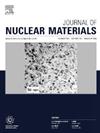Comparative characterization of mixed spectra and thermal neutron shielded irradiated tungsten
IF 2.8
2区 工程技术
Q3 MATERIALS SCIENCE, MULTIDISCIPLINARY
引用次数: 0
Abstract
The effect of mixed spectra and thermal neutron shielded irradiation on tungsten was evaluated with plasma exposure in the tritium plasma experiment followed by thermal desorption spectroscopy, X-ray photoelectron spectroscopy, and transmission electron microscopy. The two different irradiation campaigns were performed at the High Flux Isotope Reactor to 0.39–0.74 displacement per atom (dpa) in the 894–1379 K temperature range. A neutron spectrum influence on the void size and void number density was not observed. However, a strong correlation was found between void size and void number density with temperature, but not with dpa in the limited dpa range of this study. Thermal neutron shielding significantly reduced the transmutation to Re+Os. Higher irradiation temperature will lead to larger voids with lower number density, which reduces deuterium retention. Grain growth was also observed for high-temperature irradiation of over ∼1300 K within the limited grains visible in the transmission electron microscopy specimens.
混合光谱和热中子屏蔽辐照钨的特性比较
在氚等离子体实验中,通过等离子体照射评估了混合光谱和热中子屏蔽辐照对钨的影响,随后进行了热解吸光谱分析、X 射线光电子能谱分析和透射电子显微镜分析。在 894-1379 K 的温度范围内,在高通量同位素反应堆进行了两种不同的辐照活动,每原子位移 (dpa) 在 0.39-0.74 之间。没有观察到中子谱对空隙大小和空隙数密度的影响。然而,在本研究有限的 dpa 范围内,空隙尺寸和空隙数密度与温度之间存在很强的相关性,但与 dpa 无关。热中子屏蔽大大降低了向 Re+Os 的嬗变。辐照温度越高,空隙越大,空隙数密度越低,从而减少了氘的保留。在透射电子显微镜试样中可见的有限晶粒内,超过 1300 K 的高温辐照也观察到了晶粒生长。
本文章由计算机程序翻译,如有差异,请以英文原文为准。
求助全文
约1分钟内获得全文
求助全文
来源期刊

Journal of Nuclear Materials
工程技术-材料科学:综合
CiteScore
5.70
自引率
25.80%
发文量
601
审稿时长
63 days
期刊介绍:
The Journal of Nuclear Materials publishes high quality papers in materials research for nuclear applications, primarily fission reactors, fusion reactors, and similar environments including radiation areas of charged particle accelerators. Both original research and critical review papers covering experimental, theoretical, and computational aspects of either fundamental or applied nature are welcome.
The breadth of the field is such that a wide range of processes and properties in the field of materials science and engineering is of interest to the readership, spanning atom-scale processes, microstructures, thermodynamics, mechanical properties, physical properties, and corrosion, for example.
Topics covered by JNM
Fission reactor materials, including fuels, cladding, core structures, pressure vessels, coolant interactions with materials, moderator and control components, fission product behavior.
Materials aspects of the entire fuel cycle.
Materials aspects of the actinides and their compounds.
Performance of nuclear waste materials; materials aspects of the immobilization of wastes.
Fusion reactor materials, including first walls, blankets, insulators and magnets.
Neutron and charged particle radiation effects in materials, including defects, transmutations, microstructures, phase changes and macroscopic properties.
Interaction of plasmas, ion beams, electron beams and electromagnetic radiation with materials relevant to nuclear systems.
 求助内容:
求助内容: 应助结果提醒方式:
应助结果提醒方式:


